How To Grow Cannabis On A Balcony Or Terrace
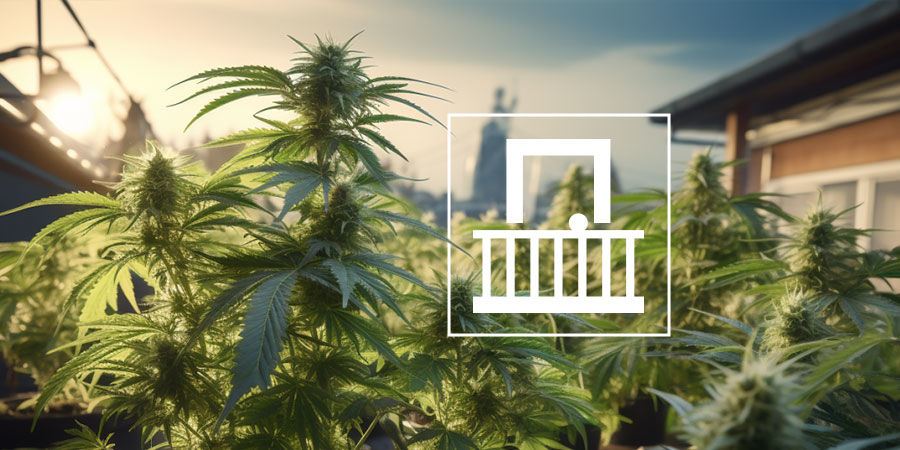
Living in an apartment or flat, you can often find yourself running a little low on available space at the best of times. This is especially true when looking for a dedicated area to grow some cannabis. Well, fear not! In this guide, we take a look at the do's and don’ts of growing on your balcony or terrace.
You can grow weed pretty much anywhere there's light, and if you can't find a suitable location, you can always bring the light to them! However, for those of you with balconies and terraces that get plenty of natural sunlight, finding that 'suitable location' is easy. In this article, we explore growing weed on a balcony or terrace, taking you through fundamentals, getting started, and plant maintenance.
The pros and cons of growing weed on a balcony
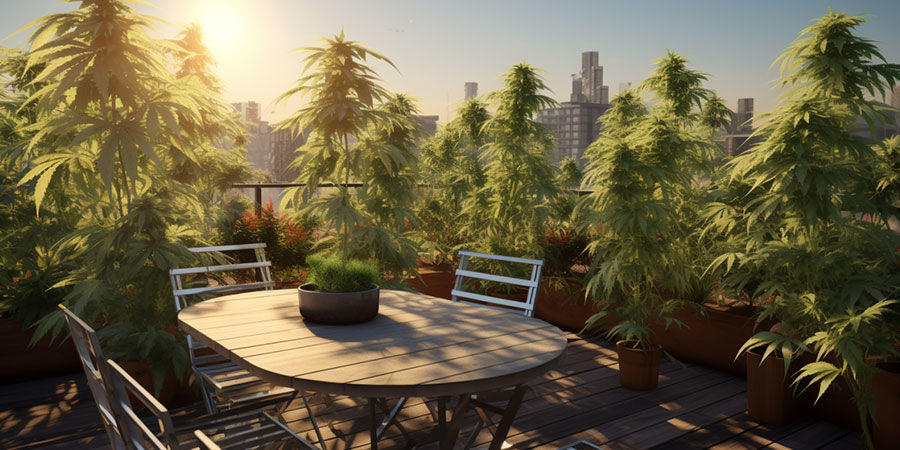
Growing cannabis on a balcony is obviously convenient—if you have one—and this is reason enough for many to try it. However, most terraces don't offer the perfect environment for growing cannabis, so you’ll need to plan your grow op carefully.
Pros of growing on a balcony or terrace
- If south facing, then they provide an environment with adequate hours of direct sunlight
- Easy access from your apartment/house
- Doesn't require lighting or ventilation
- Cheaper than indoor growing
- An effective way to grow a handful of small plants
Cons of growing on a balcony or terrace
- Most balconies or terraces don't provide enough space to grow many plants
- If they're not south facing, you might have problems getting enough light. North-facing balconies and terraces will not work
- It can be difficult to keep a grow secret, especially from neighbours
Growing cannabis on a balcony or terrace: The fundamentals
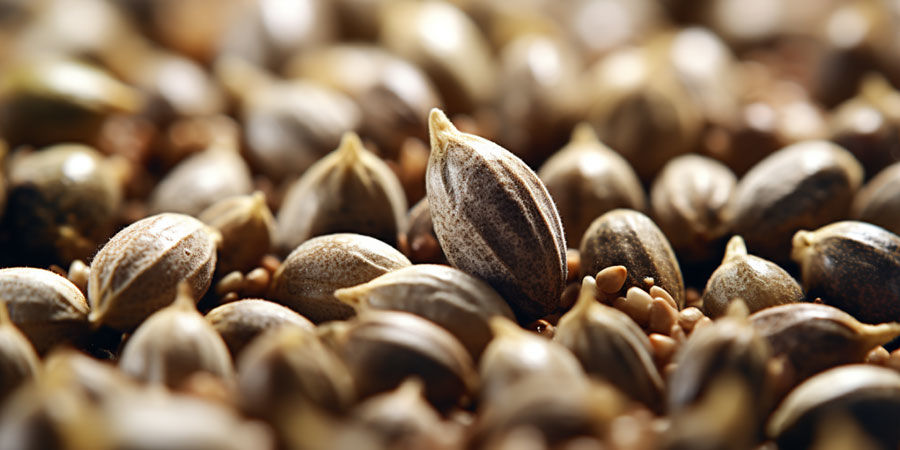
Growing cannabis on a balcony or terrace isn't much different to growing outdoors in a garden. However, there are a few crucial points you need to be aware of. Choosing the most suitable strains alongside optimal training techniques will really help to get the most out of your balcony project and keep your grow as secret as possible!
Strain choice
First things first, pick a suitable strain!
You don't want to grow some massive two-metre-tall sativa landrace that towers over everything else. Not only will it be glaringly obvious that you're growing weed, but you'll draw unnecessary attention to yourself.
Moreover, most balconies and terraces don't have the space to accommodate plants of this size, and you'll end up making your life more complicated than it needs to be. Plus, these strains need a lot of sun, so some grow spaces simply won't work. What are your options, then?
In most scenarios, Indica or indica-leaning plants are the best choices. Photoperiod plants will require a good dose of sunlight per day and might need some training to keep them under control, but they should work if you have previous cultivation experience.
Autos offer the easiest solution, requiring less direct sunlight and being generally smaller and easy to care for. If you're only going to grow a small amount of weed on your balcony, then an autoflowering variety is probably your safest bet.
Concealment
For the vast majority of people, it's going to be essential you keep your grow op fairly secretive. At the very least, you don't want it on show for passersby to see. The easiest way to do this is with companion plants. Clutter your balcony or terrace with a range of leafy beings, and one or two small cannabis plants will soon disappear among the foliage.
An eagle-eyed neighbour still might be able to pick them out if they take a good look. Still, most people will just see a beautiful collection of plants and not look too closely!
If you really need to hide your plants, consider putting up a mesh screen so that light can get through, but people who are looking can't discern what's growing behind the screen. Bear in mind that covering your balcony might inadvertently indicate what's growing there.
Training Techniques
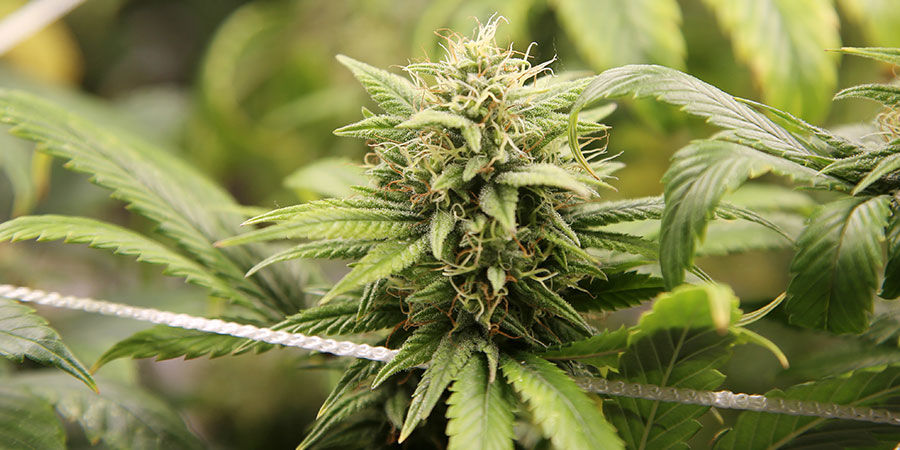
Thankfully, training cannabis plants can help keep them much smaller while also improving the final yield!
For total beginners, it's probably best to avoid training, as if you do it wrong, you can stress your plants out too much and reduce the yield. Also, most growers agree that all, bar the lightest training, is too much for autoflowering plants anyway and that it's best to leave them to their own devices.
However, if you do fancy training your cannabis plants, here are some options:
- ScrOG: Screen of green works by weaving a plant's canopy through a mesh screen to flatten it and expose more leaves to direct sunlight. This encourages lower colas to produce more bud than they otherwise would and helps keep the plant smaller.
- LST: Low-stress training is straightforward and well-suited to total beginners. It simply involves bending the stem of a young plant and tying it down horizontally. This causes the plant to grow laterally instead of vertically and exposes more of it to sunlight, increasing bud production. Again, it also helps to keep the plant height under control.
- Fimming: A more aggressive training method involving pinching and cutting the topmost dominant shoot. This causes it to regrow as four primary shoots. You can even repeat fimming multiple times during the vegetative stage to generate several more colas. As well as increasing the yield, it also encourages the plant to grow outwards rather than upwards.
Pot size
A smaller pot means a smaller plant. And likewise, a larger pot will encourage the root system to grow liberally, which translates to those tall, towering plants we mentioned earlier. Sticking to a small pot size—around 10–20L—will encourage a reasonably small plant but still big enough to produce respectable yields.
However, suppose you have ample space and are not worried about stealth. In that case, you can increase the pot size to whatever fits to grow the biggest plant possible!
Planting schedule
Planting your seeds as early as possible gives them the longest time to veg and grow. When these plants come to flower, they will produce more buds than plants which vegged for a shorter period.
However, unless you live somewhere warm, you probably don't want to move your plants outside until mid-April. Temperatures below 12ºC will damage young plants, and frost will probably kill them off.
What you can do, though, is germinate your seeds indoors and grow your seedlings under CFL lights for around two weeks before moving them outside. This gives them two weeks of extra growth and gets them through their most vulnerable stage in a safe environment. If you opt for this method, don't just stick them outside immediately after the two weeks. Instead, you'll need to gradually move them outside to acclimatise them. This process is known as hardening off.
Growing cannabis on a balcony or terrace: Step-by-step guide
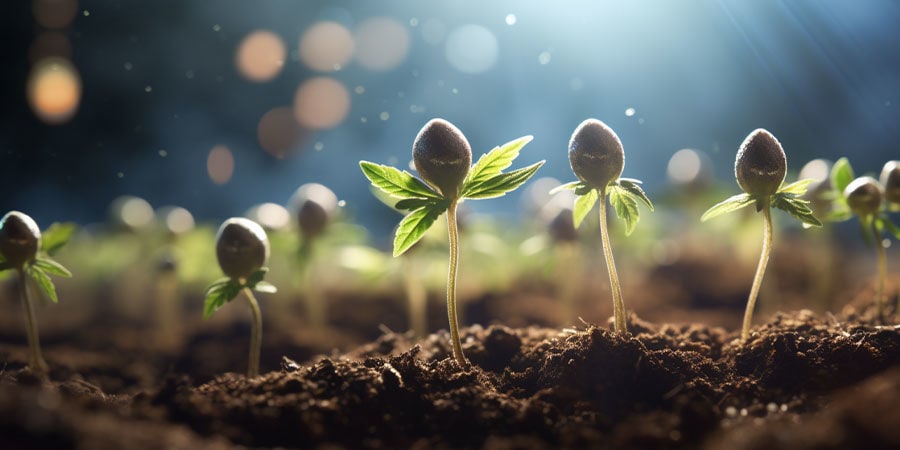
One of the great things about growing on a balcony or terrace is that, as long as it gets enough sun, it's really straightforward. Still, growing weed well always requires some work and a fair bit of knowledge. Below, we'll outline how to grow weed on a balcony or terrace.
Germination
You first have to plant and germinate seeds. Depending on when you want to start your grow and what kind of seeds you're using, there are a couple of ways to do this.
Photoperiod seeds
If you're growing photoperiod seeds and you want to start them indoors (more on this shortly), then you'll want to germinate indoors in a propagation chamber. In this case, you'll want to plant seeds around 10mm deep in a soil plug and water until the plug is very moist, but not soaking wet. Keep the temperature around 23ºC and the humidity high. After 3–10 days, you should see the first sprout emerging.
Water the seedling regularly until it has three true sets of leaves, at around 10–14 days old. At this point, it is ready to be transplanted into a larger pot and moved onto the balcony.
Autoflowering seeds
If growing auto seeds, you can germinate as listed above, except for the part about transplanting to a larger pot. Instead, many growers choose to germinate seeds in the final container. In this case, plant the seed around 10mm deep in soil and water. Placing cling film over the top of the pot and piercing it with several holes can help to maintain the high humidity needed for germination.
Getting started indoors
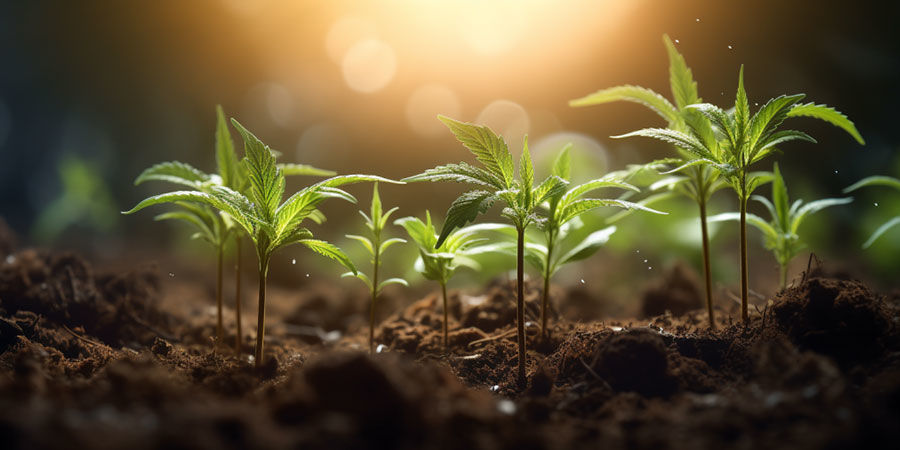
If you're growing photoperiod seeds, you want them to have as much time outdoors during the veg period as possible, so you'll want to germinate them as early as possible. Plus, you'll probably start them in a propagation chamber and then transplant them to bigger pots. All this means that your best bet is to start plants indoors under CFL lights, as mentioned above.
Once the seeds have germinated, you'll need to keep it indoors for around 10–14 days until it has three true sets of leaves. During this period, either keep them on a sunny windowsill or under CFL lights. Also, consider using a desk fan to continually blow air over them. This movement helps to strengthen their stems and prepare them for life outdoors. Without this, you'll find a slight breeze can knock them over!
Transferring to the balcony or terrace
Once the seedlings are around two weeks old, transplant them to their final container and move them outdoors.
As mentioned, don't just stick them outdoors one day and leave them be, as the shock of the outdoor climate can stress and maybe even kill them. So, if transferring plants from indoors to outdoors, you need to harden them off first.
To harden cannabis plants off, first move them to a shaded patch for around one hour on the first day, then take them back indoors. For the following couple of days, you should extend their time in the shade by around an hour a day.
After four or five days, begin to expose them to direct sunlight. It might sound strange, but direct sunlight can overwhelm and burn plants reared under artificial lights, so they need time to get accustomed.
After a few more days, when they have become used to direct sunlight, leave them outdoors from morning until evening and bring them in only at night. If they seem totally healthy, the next day, you can leave them outdoors for the remainder of the grow.
If they appear to be struggling at any point, move them back indoors until they are fully recovered.
Plant maintenance and training
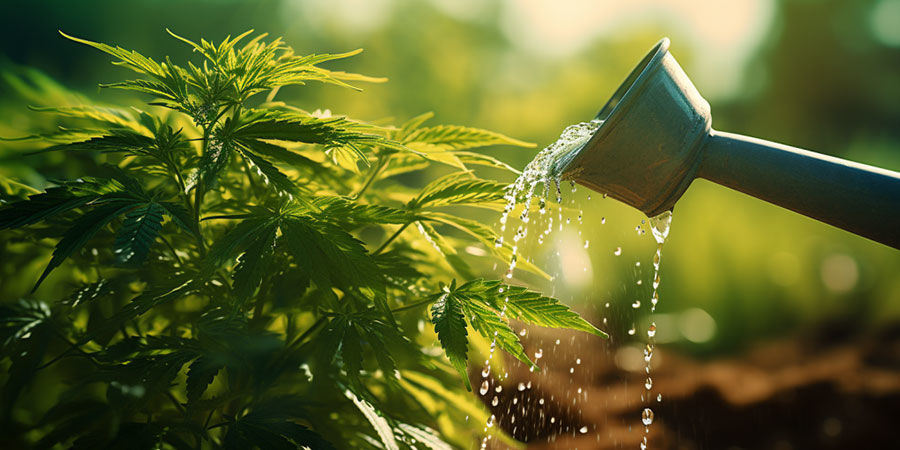
Once your plants are outdoors and growing, you'll need to look after them and keep them healthy. Also, now's the time to employ any training techniques, as once plants start to flower, it'll be too late.
How to look after vegging cannabis plants:
- Watering: Only water plants when the top 10mm or so of soil is dry to the touch. If it's still moist, your plants don't need watering! Overwatering is common among novice growers, and your plants won't thank you for it.
- Feeding: Underfeeding is much better than overfeeding. Fortunately, a handy way to manage feeding is using only organic fertilisers. Doing so makes it hard to overfeed plants while also being better for the environment. Regardless of which nutrients you use, start with very little feed for the first three weeks; until then, your soil should contain adequate nutrients. After three weeks, start small and increase gradually using the instructed amounts. For autoflowering plants, use a quarter or half as much as required.
- Checking for pests: Regularly check your plants for signs of infestation. Pests could be directly visible, or you might have to discern their presence by diagnosing specific symptoms. The chances of pests are higher on a balcony or terrace compared to indoor grow ops.
Flowering and harvest
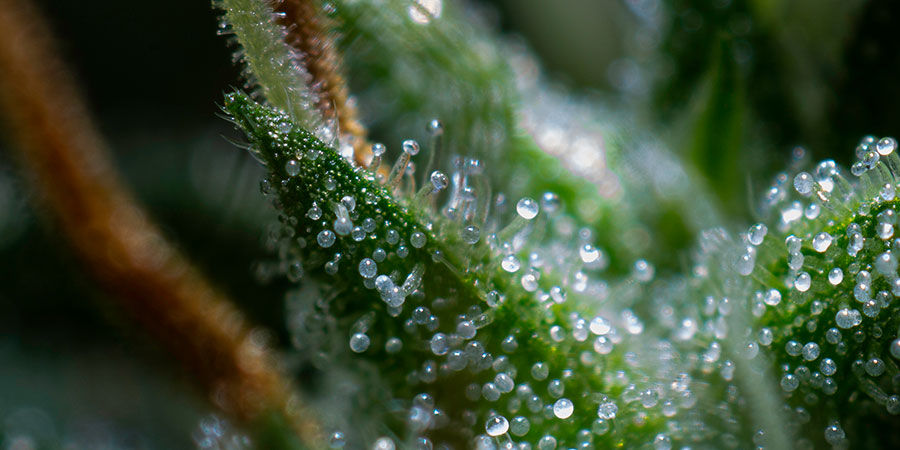
At some point, your plants will begin to flower. This will either happen sometime after the summer solstice or at a genetically pre-allotted point (autoflowering plants). Either way, the maintenance process for balcony-based plants changes from this point onwards.
Flowering
Flowering cannabis plants require a different balance of nutrients, so you should use a bloom feed rather than a veg feed. Besides the initial growth spurt at the beginning of flowering (when a plant can double in size in a few days), your plant's energy is now devoted to developing flowers.
It's crucial you keep conditions as balanced as possible during the flowering stage. Unfortunately, stress at this pivotal juncture can make plants hermaphroditic. While this stress adaptation is pretty cool, as it can make plants grow male sexual organs and self-pollinate, it's annoying for growers. Self-pollination will actually reduce the final yield, replacing trichome-rich buds with seed-rich buds. So treat your plants well and keep them as happy as possible!
A week before harvest, some growers choose to "flush" their plants. This involves watering with several litres of pure water, effectively flushing all the fertiliser out of the soil. Some believe that this causes the plant to use up the nutrient reserves it has stored in its cells and ultimately improves the quality of buds. Flushing isn't essential, and the total yield won't be affected whether you choose to do it or not.
Harvest
The best way to tell if a plant is ready for harvest is not by counting down the days listed on the seed's packaging, but by taking visual cues from the plant itself. The trichomes on your buds will give you the clearest indication of whether the plant is ready to be harvested. However, you'll want to use a pocket microscope to take a detailed look at them. The following ratios indicate the various stages of cannabinoid development:
- Mostly clear trichomes: If most of the trichomes are clear, then the plant is not mature enough to be harvested. These trichomes don't contain the maximum amount of THC yet.
- 70% milky white trichomes: If at least 70% are milky white, this is the perfect moment to harvest. At this stage, the flowers will have the highest concentration of THC.
- Mostly amber trichomes: If many of the trichomes have turned amber, then they have passed the optimal harvest window, and the THC is degrading into CBN. If this is the case, harvest immediately, as you will only continue to lose THC.
To harvest, cut whole branches off and hang them upside down for 10–14 days at around 20ºC. Use a fan to keep air moving and humidity low, and keep light exposure to a minimum, as this also degrades THC.
Once dry, trim the sugar leaves and remove the buds from the branches. Now all you need to do is cure them in airtight glass jars. Place buds in jars and briefly open each jar once or twice daily. This is known as burping, which lets the humid air out and fresh air in. You should cure buds for at least a week before your weed is ready to smoke. Be aware, though, that the better your bud will taste.
Growing great weed on a balcony or terrace
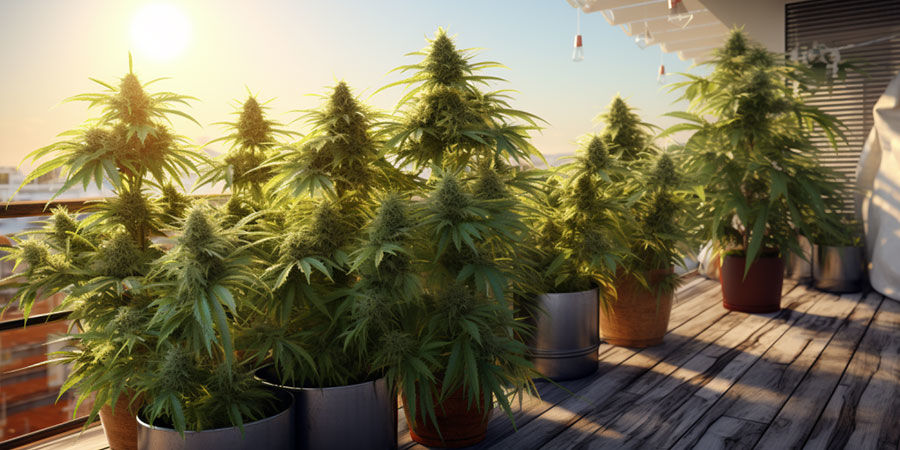
Providing plants get enough direct sunlight, balconies and terraces offer brilliant growing environments, as the process hardly differs from growing elsewhere outdoors. However, strain choice, pot size and training methods are crucial considerations, especially if you want plants to remain small and stealthy. Generally, though, growing on a balcony or terrace is pretty easy, so why not try it today?





 United States
United States











